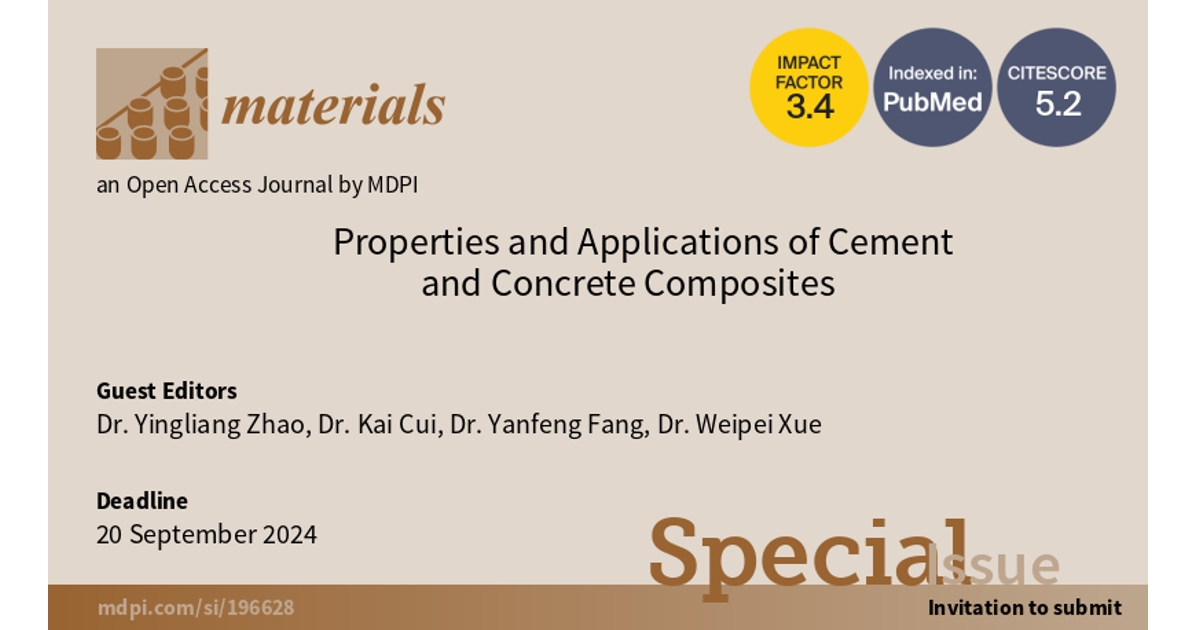Properties and Applications of Cement and Concrete Composites
A special issue of Materials (ISSN 1996-1944). This special issue belongs to the section "Construction and Building Materials".
Deadline for manuscript submissions: 20 September 2024 | Viewed by 1190

Special Issue Editors
Interests: waste management and recycling; low-carbon cementitious materials; mineral carbonation
Interests: carbonation; UHPC; nanomaterials; utilization of industrial wastes
Special Issues, Collections and Topics in MDPI journals
Interests: mineral carbonation; low-carbon cementitious materials; utilization of industrial wastes; hydration chemistry of cement
Special Issues, Collections and Topics in MDPI journals
Interests: high-strength and high-performance concrete; hydraulic coupling characteristics; damage mechanism; constitutive model; durability of concrete materials
Special Issues, Collections and Topics in MDPI journals
Special Issue Information
Dear Colleagues,
Since the invention of Portland cement in 1824, cement has been developed and applied for 200 years. Cement-based materials are the world's most widely used building materials due to their wide range of raw materials and low cost. However, cement-based materials come with a number of disadvantages, such as high brittleness, easy cracking, low tensile strength, poor durability, heavyweight, and high energy consumption. With the continuous acceleration of urbanization, there are higher requirements for developing and utilizing cement-based materials. Cement-based materials are moving towards high strength and toughness, lightweight, multi-functionality, high efficiency, intelligence, and sustainable development. This Special Issue mainly focuses on the latest research on cement and concrete and realizes the high-value utilization of cement-based composite materials through research in different dimensions.
Possible research topics include, but are not limited to, the following:
- Fiber-reinforced concrete;
- Low-carbon cement and concrete;
- Solid waste utilization of building materials;
- Carbonation of building materials;
- Durability of concrete;
- Alkali-activated cement-based materials;
- Nanomaterial-reinforced cement-based materials;
- Engineering application of concrete.
Dr. Yingliang Zhao
Dr. Kai Cui
Dr. Yanfeng Fang
Dr. Weipei Xue
Guest Editors
Manuscript Submission Information
Manuscripts should be submitted online at www.mdpi.com by registering and logging in to this website. Once you are registered, click here to go to the submission form. Manuscripts can be submitted until the deadline. All submissions that pass pre-check are peer-reviewed. Accepted papers will be published continuously in the journal (as soon as accepted) and will be listed together on the special issue website. Research articles, review articles as well as short communications are invited. For planned papers, a title and short abstract (about 100 words) can be sent to the Editorial Office for announcement on this website.
Submitted manuscripts should not have been published previously, nor be under consideration for publication elsewhere (except conference proceedings papers). All manuscripts are thoroughly refereed through a single-blind peer-review process. A guide for authors and other relevant information for submission of manuscripts is available on the Instructions for Authors page. Materials is an international peer-reviewed open access semimonthly journal published by MDPI.
Please visit the Instructions for Authors page before submitting a manuscript. The Article Processing Charge (APC) for publication in this open access journal is 2600 CHF (Swiss Francs). Submitted papers should be well formatted and use good English. Authors may use MDPI's English editing service prior to publication or during author revisions.
Keywords
- carbonation
- solid waste utilization
- cement-based composites
- microstructure
- engineering application
- mechanical properties
- durability
- supplementary cementitious materials









